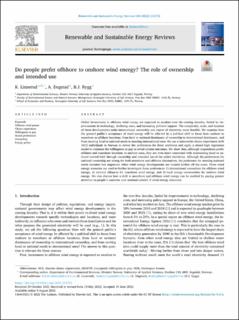| dc.contributor.author | Linnerud, Kristin | |
| dc.contributor.author | Dugstad, Anders | |
| dc.contributor.author | Rygg, Bente Johnsen | |
| dc.date.accessioned | 2022-10-03T10:59:28Z | |
| dc.date.available | 2022-10-03T10:59:28Z | |
| dc.date.created | 2022-08-03T17:40:18Z | |
| dc.date.issued | 2022 | |
| dc.identifier.citation | Linnerud, K., Dugstad, A., & Rygg, B. J. (2022). Do people prefer offshore to onshore wind energy? The role of ownership and intended use. Renewable and Sustainable Energy Reviews, 168:112732. | en_US |
| dc.identifier.issn | 1364-0321 | |
| dc.identifier.uri | https://hdl.handle.net/11250/3023317 | |
| dc.description.abstract | Global investments in offshore wind energy are expected to escalate over the coming decades, fueled by improvements in technology, declining costs, and increasing political support. The complexity, scale, and location of these developments make international ownership and export of electricity more feasible. We examine how the general public's acceptance of wind energy will be affected by a political shift in focus from onshore to nearshore or offshore locations, from local or national dominance of ownership to international dominance, and from meeting local or national needs to meeting international ones. We use a nationwide choice experiment with 1612 individuals in Norway to reveal the preferences for these attributes and apply a mixed logit regression model to estimate the willingness to pay to avoid certain outcomes. We show that, although respondents prefer offshore and nearshore locations to onshore ones, they are even more concerned with maintaining local or national control both through ownership and intended use of the added electricity. Although the preferences for national ownership are strong for both nearshore and offshore alternatives, the preference for meeting national needs becomes less important when wind energy developments are located farther off the coast. Three wind energy scenarios are used to further investigate these preferences: 1) international consortium for offshore wind energy, 2) national alliances for nearshore wind energy, and 3) local energy communities for onshore wind energy. We also discuss how a shift to nearshore and offshore wind energy can be enabled by paying greater attention to people's concerns over national control of wind energy resources. | en_US |
| dc.language.iso | eng | en_US |
| dc.publisher | Elsevier | en_US |
| dc.rights | Navngivelse 4.0 Internasjonal | * |
| dc.rights.uri | http://creativecommons.org/licenses/by/4.0/deed.no | * |
| dc.title | Do people prefer offshore to onshore wind energy? The role of ownership and intended use | en_US |
| dc.type | Peer reviewed | en_US |
| dc.type | Journal article | en_US |
| dc.description.version | publishedVersion | en_US |
| dc.rights.holder | © 2022 The Authors. | en_US |
| dc.source.volume | 168 | en_US |
| dc.source.journal | Renewable & Sustainable Energy Reviews | en_US |
| dc.identifier.doi | 10.1016/j.rser.2022.112732 | |
| dc.identifier.cristin | 2041035 | |
| dc.relation.project | Norges forskningsråd: 296205 | en_US |
| dc.relation.project | Norges forskningsråd: 764717 | en_US |
| dc.relation.project | Norges forskningsråd: 238281 | en_US |
| dc.source.articlenumber | 112732 | en_US |
| cristin.ispublished | true | |
| cristin.fulltext | original | |
| cristin.qualitycode | 1 | |

